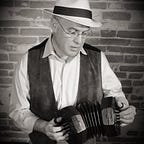CONCERTINA FACE
Some years back a neighbor, who could hear me practicing, was curious about me and my concertina. He and his wife showed up one evening at the Café where I performed every week. The next day he stopped by to say they had a great time and really enjoyed the music. Then he asked, “Why aren’t you smiling when you play?”
I wasn’t even aware whether I did or did not smile. I know that I do smile and often. I mean, I am an overall a pretty jovial kind of bloke. So, when the next week rolled around and I played in the Café, I tried to concentrate on smiling. I focused on facing the patrons in the café and making sure I smiled. With teeth showing and sometime without for varying looks. It felt incredibly forced. In addition, I found myself making mistakes as I played because I was thinking more about my smile than my music.
And there you have it. Concertina Face. Just about every concertina player has one. Some have a look of bliss and some a look of pain. But in every case it is because the player is concentrating on every aspect of playing a very complicated instrument. The concertina has bellows. Moving the bellows back and forth (in/out) forces air through reeds organized on the inside in a reed pan that vibrate to make a note.
The concertina has two sides that contain rows of buttons. Each button, when properly pressed, play that corresponding reed that you are pushing air into that plays a corresponding musical note. Some concertinas have 64 or more buttons. Some only 22. In the English system of the concertina (chromatic), when moving the bellows in and out, the same note is sounded. In the Anglo system of the concertina (diatonic), it is a different note. Add in playing music that requires aspects of tempo, dynamics, phrasing, melody, chords, etc. and you understand why the player might be in the midst of a facial gymnastics.
I recently did a prerecorded concert for the first annual World Concertina Day. It was wonderful to have a project and perform music for a purpose again. I noticed, in addition to my concertina face, I turn my head to the right. I also do this when having a conversation in a noisy room as I have some hearing loss in my right ear (too many Eric Clapton and Phish concerts). Now, it has become automatic when I play as an internal mechanism to my concentration.
I watched myself play. Head turned, concentrating. I know I was listening to my bandmates as we played, careful to engage musically and creatively. I also see someone I don’t really recognize. I see someone older. Less hair and a different color than I remember. The face lined and the body less trimmed. I still think as a 27-year-old but feel age seeping into joints and bones at the end of a practice and day. My only hope is what I gain in age I will lack in maturity.
There are not many photos of the myriad of gigs and performances from my past. Nothing archived in files of social media apps. I know there may be a few photos taken by friends, but many have long faded or been lost. My memory is intact and remember a lot of the places I performed. The where and even sometimes what I played, but never how my face expressed itself.
Learning and playing the concertina is hard. It takes time and perseverance. If you play this or a similar bellowed instrument, then you understand why we endure for the love of this instrument. I am a performer at heart. I play for the pure enjoyment in creating and making music. For my personal fulfillment. I know how playing makes me feel regardless of how it looks. It started out hard to learn and hard to play. It became effortless but never easy. To quote Tom Hanks from the movie A League Of Their Own, “Of course it’s hard. It’s supposed to be hard. If it was easy, everyone would do it. Hard is what makes it great.”
